ELIMINATION OF SICKLE CELL ANAEMIA
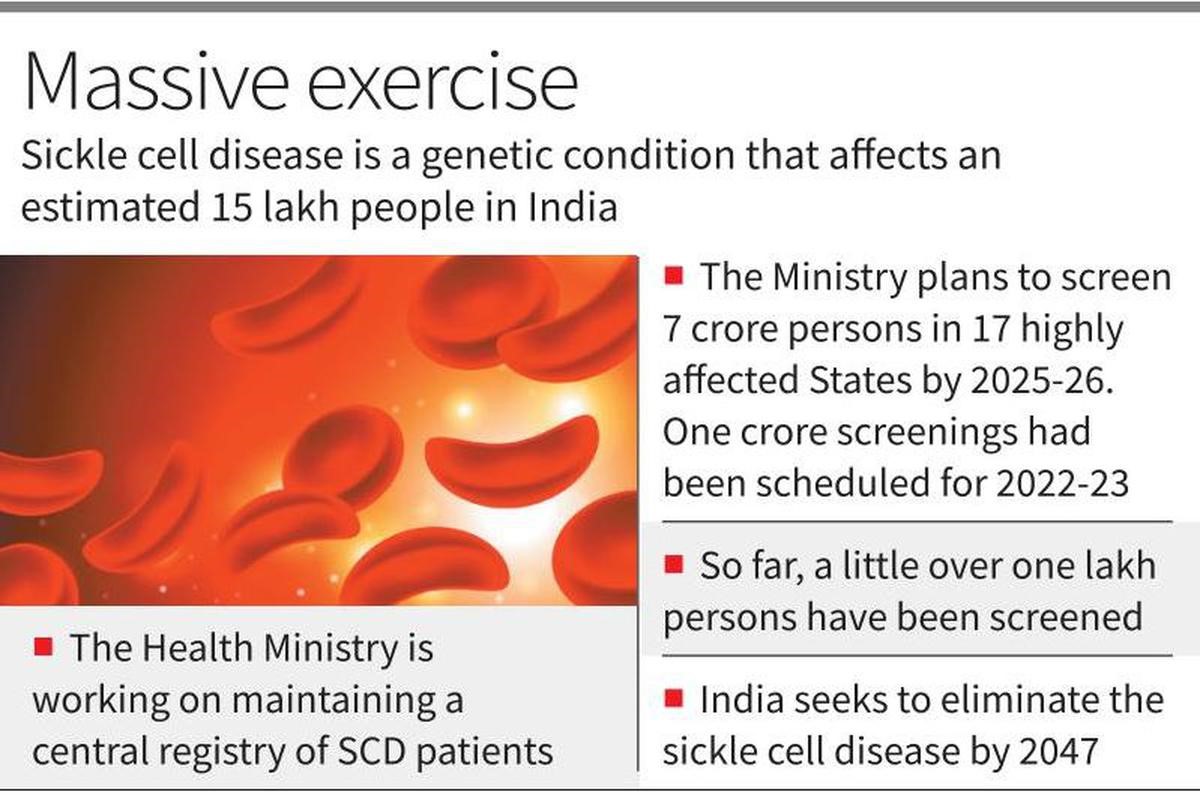
Context
- Sickle cell anaemia is a disease that impacts the tribal sections of society significantly. The government is committed to eliminating sickle cell by 2047.
Key Details:
- This was the statement of our honorable Prime Minister while he launched the sickle cell eradication mission in Madhya Pradesh.
- Additional secretary, of the Ministry of Tribal Affairs, Miss Jaya stated that It is a blood disorder.
- In a normal person, the person who does not have sickle cell disease, the red blood cells are round in shape, and they move smoothly along the blood vessels.
- But when a person has sickle cell disease, the red blood cells become sickle cell shaped. They become crescent moon-shaped and therefore they may cling to the lining of the blood vessel.
- Or it would be difficult for them to flow in the same manner as a normal red blood cell. Therefore the person experiences a lot of symptoms which can make it very difficult for him to lead a normal life.
- And it is possible that his longevity may also be affected. So he will have what we call a pain crisis where his joints would be paining terribly without medical attention. It cannot be handled. He may develop jaundiced eyes. He would be showing a load of eyes.
- He would have frequent fevers and fatigue, and his immunity would be compromised. So these are the kinds of symptoms.
- And if they are ignored, of course, there could be gradual organ failure also. And he may develop other kinds of diseases. Hence it is essential that we know the status of a person, especially in these areas where sickle cell is said to be endemic.
| Sickle cell disease is a genetic blood disorder characterized by abnormal red blood cells that take on a crescent or sickle shape and these irregularly shaped cells can cause blockages in blood vessels, leading to a variety of health complications. |
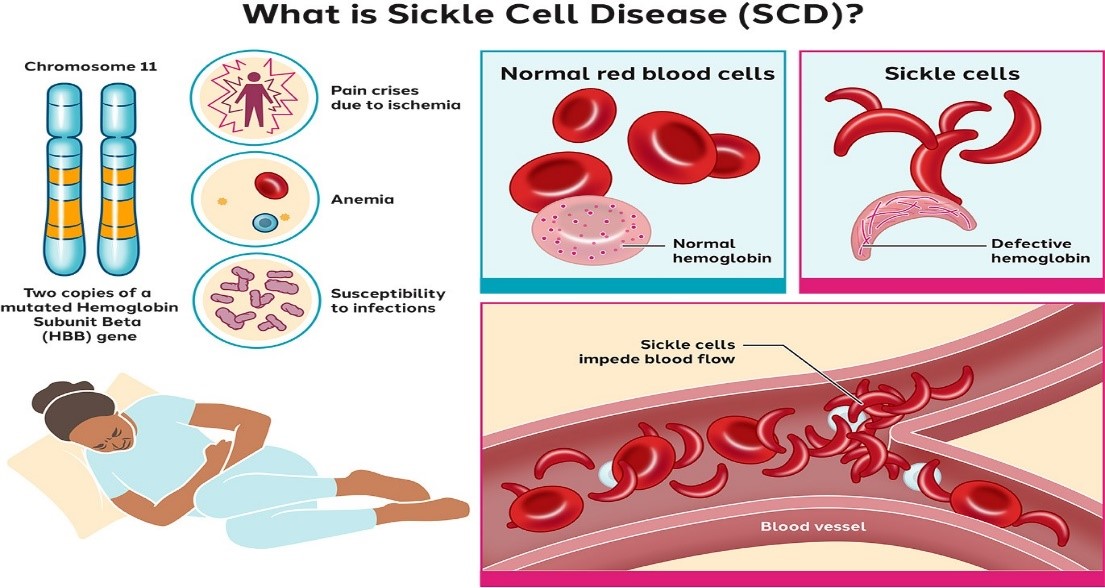
About Sickle Cell Anaemia (SCA)
|
About
|
- Sickle cell anaemia (SCA) is a genetic disorder that affects the shape and function of red blood cells (RBCs), which carry oxygen to all parts of the body.
|
|
Extent
|
- SCA is one of the most common inherited blood disorders in the world, affecting millions of people, especially those of African, Asian and Mediterranean descent.
|
|
Status in India
|
- SCA is prevalent in some tribal and non-tribal communities in states like Maharashtra, Madhya Pradesh, Chhattisgarh, Gujarat, Odisha, Jharkhand and Bihar.
- According to a 2018 report by the Indian Council of Medical Research (ICMR), about 1.2% of the Indian population has sickle cell trait (SCT), which means they carry one copy of the mutated gene that causes SCA.
|
Types Of Sickle Cell Anaemia:
- Haemoglobin SS disease occurs when the child inherits copies of the haemoglobin S gene from both the parents.
- Haemoglobin SC disease occurs when the child inherits the Hb C gene from one parent and the Hb S gene from the other.
- Haemoglobin SB+ (beta) thalassemia is inherited with the Hb S gene.
- Haemoglobin SB 0 (Beta-zero) thalassemia is the fourth type of sickle cell disease which has similar symptoms to Hb SS anaemia.
- Haemoglobin SD , haemoglobin SE and haemoglobin SO are some of the rare types of sickle cell anaemia.
- Sickle cell trait occurs when the child inherits a mutated gene (haemoglobin S) from one parent.
Causes of Sickle Cell Anaemia:
Genetic Inheritance:
- Sickle cell anemia is an autosomal recessive genetic disorder. A person needs to inherit a copy of the mutated gene from both parents to develop the condition. If both parents carry the sickle cell trait, there is a 25% chance with each pregnancy that their child will have sickle cell anemia.
Hemoglobin S Mutation:
- The specific mutation in the HBB gene results in the substitution of a single amino acid in the hemoglobin molecule. This change leads to the formation of abnormal hemoglobin S instead of normal hemoglobin A.
Ethnicity:
- Sickle cell anemia is more prevalent in certain ethnic groups, particularly those with a higher prevalence of malaria. Regions with historically high malaria incidence, such as sub-Saharan Africa, the Middle East, and parts of India, have a higher frequency of sickle cell trait carriers.
Selective Advantage Against Malaria:
- The high frequency of the sickle cell gene in certain populations is thought to be due, in part, to a selective advantage against malaria. Individuals with one copy of the sickle cell gene (sickle cell trait) may have increased resistance to malaria, which has led to the persistence of the gene in these populations.
Elimination of Sickle Cell Anaemia:
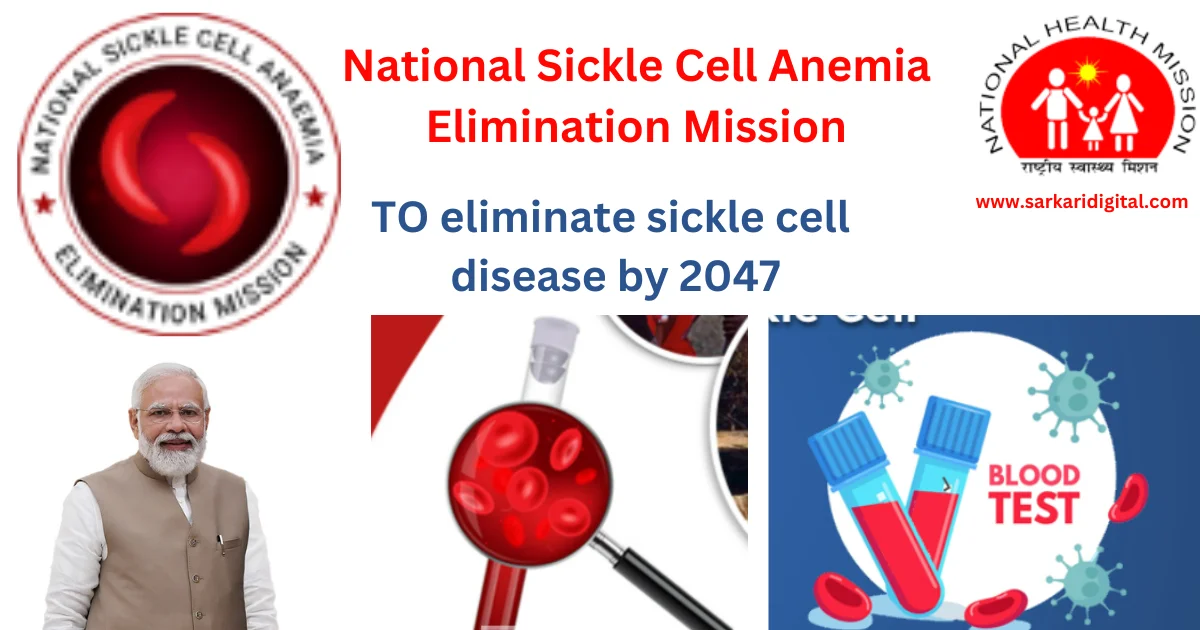
Background of National Sickle Cell Anaemia Elimination Mission:
Aim of the mission:
- The Mission aims to address the pressing health challenges posed by sickle cell disease, particularly among the tribal population. The launch will mark a crucial milestone in the Government’s ongoing efforts to eliminate sickle cell disease as a public health problem by 2047.
Launched:
- The National Sickle Cell Anaemia Elimination Mission was announced in the Union Budget 2023.
Objectives:
- The mission will create awareness among the public and health workers about the prevention and management of sickle cell anaemia.
- It will reduce the morbidity and mortality associated with sickle cell anaemia, and enhances the quality of life of the affected individuals and families.
- It will also contribute to the achievement of the Sustainable Development Goals related to health, education and social inclusion.
Implementation:
- This will be implemented in 278 districts of 17 high-focus states in the country namely Gujarat, Maharashtra, Rajasthan, Madhya Pradesh, Jharkhand, Chhattisgarh, West Bengal, Odisha, Tamil Nadu, Telangana, Andhra Pradesh, Karnataka, Assam, Uttar Pradesh, Kerala, Bihar, and Uttarakhand.
Components of the mission:
Screening
- All newborns and pregnant women will be screened for sickle cell trait or disease using a simple and rapid test.
- Those who are found positive will be given a genetic status card, which will help them in accessing appropriate health care and counselling services.
Prevention
- Couples who are carriers of sickle cell trait will be counselled about the risk of having a child with sickle cell disease and the available options for prevention.
- Prenatal diagnosis and medical termination of pregnancy will be offered to those who wish to avoid having an affected child.
Treatment
- Patients with sickle cell disease will be provided with free and regular treatment, including blood transfusions, hydroxyurea therapy, pain management and antibiotic
- They will also be enrolled in a national registry, which will help in monitoring their health outcomes and quality of life.
Research
- The mission will support research and innovation in the field of sickle cell anaemia, such as developing new drugs, vaccines, gene therapy and stem cell therapy.
- It will also promote awareness and education among the public and health professionals about the disorder.
Closing thoughts
- Sickle cell anemia is a hereditary condition, its severity can vary among individuals. Advances in medical care and treatments have improved the prognosis for individuals with sickle cell anemia, but it remains a chronic condition that requires ongoing management.
https://newsonair.gov.in/Spotlight.aspx#
https://www.google.com/url?sa=i&url=https%3A%2F%2Fwww.thehindu.com%2Fsci-tech%2Fhealth%2Fsickle-cell-screening-meets-only-1-of-target-hurting-ambitious-elimination-goal%2Farticle66607552.ece&psig=AOvVaw0FRJm1hsQ62kfGB2jIokLk&ust=1697720917694000&source=images&cd=vfe&opi=89978449&ved=0CBMQjhxqFwoTCIDIyLLV_4EDFQAAAAAdAAAAABAE
https://www.google.com/url?sa=i&url=https%3A%2F%2Ftwitter.com%2Fairnewsalerts%2Fstatus%2F1674946624098021378&psig=AOvVaw0FRJm1hsQ62kfGB2jIokLk&ust=1697720917694000&source=images&cd=vfe&opi=89978449&ved=0CBMQjhxqFwoTCIDIyLLV_4EDFQAAAAAdAAAAABAJ
https://www.google.com/url?sa=i&url=https%3A%2F%2Fmedicaldialogues.in%2Fnews%2Fhealth%2Fmission-to-eliminate-sickle-cell-anaemia-by-2047-govt-to-provide-cards-to-tribal-people-below-40-years-106546&psig=AOvVaw0FRJm1hsQ62kfGB2jIokLk&ust=1697720917694000&source=images&cd=vfe&opi=89978449&ved=0CBMQjhxqFwoTCIDIyLLV_4EDFQAAAAAdAAAAABAV

Bihar Agriculture Roadmap 2023-2028
Context
- President Droupadi Murmu today inaugurated the Fourth Bihar Agriculture Roadmap 2023-28 at a function in Bapu Sabhagar in Patna.
Details
- The State Agriculture Roadmap envisages different innovative ideas, programmes, and ideas for the development of agriculture in Bihar. It will try to meet the challenges of climate change and its adverse effects on agriculture, which is the core competence of the state.
- The five-year, blueprint for agriculture has a special focus on climate change resilient farming and increasing the income of farmers with technological and scientific interventions.
- The President also unveiled the booklet of Bihar Agriculture Roadmap and its plaque at the function.
- The Agriculture Roadmap is a collective effort of the Agriculture Department and 11 other departments.
Significance of agriculture roadmap:
- Global warming and climate change are a crisis for the existence of entire humanity. But these affect the poor the most. She noted that Bihar has received very little rainfall in recent years.
- Bihar has been considered a water-rich state, rivers and ponds have been the identity of this state. To maintain this identity, it is very important to pay attention to water conservation.
- Climate-resilient agriculture can play an important role in dealing with the challenge of climate change.
- By bringing changes in the current farming pattern, biodiversity can be promoted, exploitation of water resources can be reduced, soil fertility can be conserved, and above all, balanced food can be delivered to the plates of people.
- It is an important step towards reducing dependence on fossil fuels, environmental protection, and energy security of the country.
https://newsonair.gov.in/News?title=President-Droupadi-Murmu-launches-Bihar-Agriculture-Roadmap-2023-2028-in-Patna&id=469606

Lok Sabha Ethics Committee
Context
- The Lok Sabha Ethics Committee will hear the matter related to a cash-for-query complaint against TMC MP Mahua Moitra on the 26th of this month.
Details:
- BJP MP Nishikant Dubey has alleged that she had taken bribes to ask questions in Parliament on behalf of a businessman to target the Adani Group and Prime Minister Narendra Modi.
- The Committee has called Mr. Dubey for oral evidence in this matter. It will also hear advocate Jai Anant Dehadrai on this issue.
About Ethics Committee:
- Primary purpose: The Lok Sabha Ethics Committee, officially known as the Committee on Ethics, is a parliamentary committee in India. It operates within the Lok Sabha, which is the lower house of the Parliament of India. The primary purpose of the Ethics Committee is to oversee the ethical conduct of Members of Parliament (MPs) and to examine complaints regarding unethical behavior.
Key functions:
- Examination of Complaints: The committee is tasked with examining complaints or allegations of unethical conduct against Members of Parliament. This can include matters related to conflict of interest, misuse of official position, and other ethical violations.
- Inquiry and Recommendations: If the committee finds merit in a complaint, it may conduct an inquiry into the matter. The committee has the authority to gather evidence, interview relevant individuals, and make recommendations based on its findings.
- Code of Conduct: The Ethics Committee also plays a role in formulating and reviewing the Code of Conduct for Members of Parliament. This code outlines the expected standards of behavior and ethical conduct for MPs.
- Advice to Members: The committee may provide advice to Members of Parliament on ethical matters, helping them navigate situations that may pose ethical challenges.
- Educational Initiatives: In addition to its investigatory functions, the Ethics Committee may engage in educational initiatives to promote ethical behavior among MPs and create awareness about ethical standards.
https://newsonair.gov.in/News?title=Lok-Sabha-Ethics-Committee-to-hear-matter-related-to-cash-for-query-complaint-against-TMC-MP-Mahua-Moitra-on-26th-October&id=469621
.jpg)
India's first Regional Rail
Context
- Prime Minister Narendra Modi will inaugurate India's first Regional Rail, RAPIDX from Sahibabad, Uttar Pradesh on Friday.
Details
- The first phase will cover a distance of 17 kilometers which includes a total of five stations - Sahibabad, Ghaziabad, Guldhar, Duhai, and Duhai Depot. The trains will run at a speed of 160 kilometers per hour at an interval of 15 minutes.
- RAPIDX train has six coaches with the capacity to carry about one thousand 700 commuters.
- One coach has been reserved for women passengers. The First Train in both directions will commence operations at 6:00 AM and the Last Train to depart from stations in both directions will be at 11:00 PM.
- The service for general passengers will be operational from Saturday. Each RAPIDX train will also have one Premium coach with a host of additional commuter-centric features like reclining seats, coat hooks, magazine holders, and footrests.
- The train will have a host of commuter-centric features for a safe and comfortable regional commute. These include 2x2 transverse seating, luggage racks, CCTV cameras, a mobile charging facility, and auto control ambient lighting system.
About Regional Rapid Transit System (RRTS):
|
About
|
- The Regional Rapid Transit System (RRTS) is a type of high-speed rail infrastructure that is designed to provide fast, reliable, and efficient transportation between cities and regions.
- It aims to reduce travel time, congestion, and pollution by offering a rapid transit alternative to traditional modes of transportation.
- RRTS projects typically involve the development of dedicated corridors for high-speed trains, incorporating modern technologies and design principles.
|
|
Objectives
|
- Dedicated Corridors: RRTS projects involve the creation of dedicated corridors or tracks exclusively for high-speed trains. These corridors are often separated from existing roadways to ensure smooth and uninterrupted travel.
- High-Speed Trains: RRTS systems use specially designed high-speed trains capable of reaching significant speeds. These trains are equipped with advanced technologies for safety, comfort, and efficiency.
- Interconnected Cities: RRTS aims to connect major cities and urban centers within a region. By linking urban areas through a high-speed rail network, it facilitates faster and more convenient travel for commuters and reduces dependence on conventional modes of transportation.
|
https://newsonair.gov.in/News?title=PM-Modi-to-inaugurate-India%26%2339%3bs-first-Regional-Rail%2c-RAPIDX-from-Sahibabad%2c-UP&id=469623
Minimum Support Prices for six Rabi Crops
Context
- Government has approved Minimum Support Prices (MSP) for six Rabi Crops for Marketing Season 2024-25.
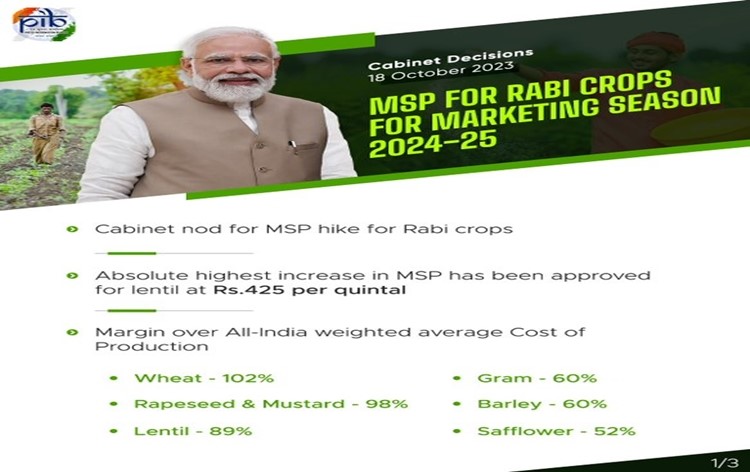
Details:
- Briefing reporters in New Delhi after the Cabinet meeting, Information and Broadcasting Minister Anurag Singh Thakur said, the highest increase of 425 rupees per quintal has been approved for lentil (masur) followed by increase of 200 rupees per quintal each for rapeseed and mustard.
- He said, an increase of 150 rupees per quintal each has been approved for wheat and safflower.
- Mr Thakur said, the Cabinet has also approved increase of 115 rupees per quintal for barley and 105 rupees per quintal for gram.
About Minimum Support Prices:
- The minimum support price (MSP) is an agricultural product price, set by the Government of India to purchase directly from the farmer. This is not enforceable by law.
- This rate is to safeguard the farmer to a minimum profit for the harvest, if the open market has lesser price than the cost incurred.
- The minimum support price (MSP) is an agricultural product price, set by the Government of India to purchase directly from the farmer. This is not enforceable by law.
- This rate is to safeguard the farmer to a minimum profit for the harvest, if the open market has lesser price than the cost incurred.
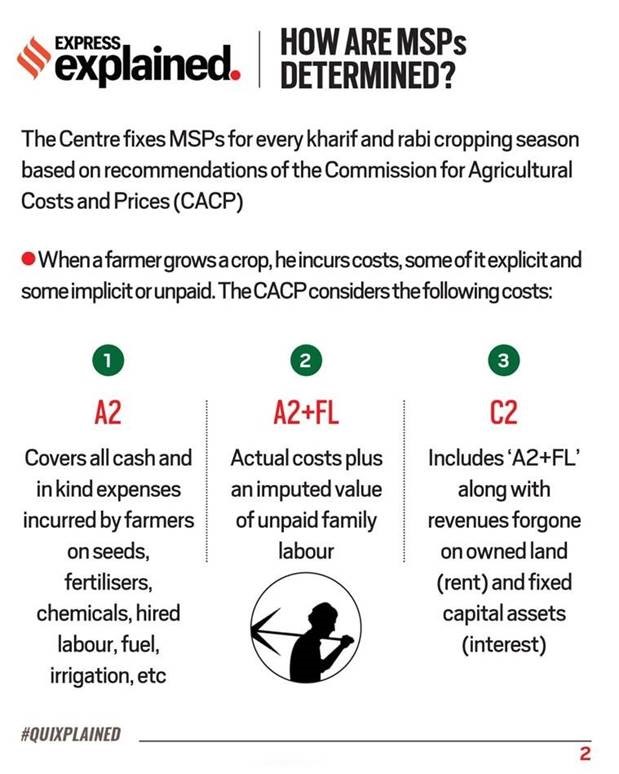
https://newsonair.gov.in/News?title=Govt-approves-Minimum-Support-Prices-for-six-Rabi-Crops-for-Marketing-Season-2024-25&id=469641








